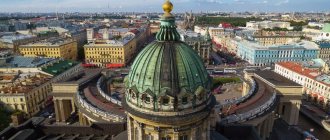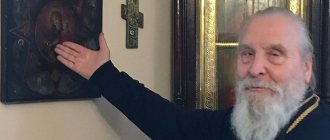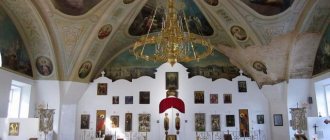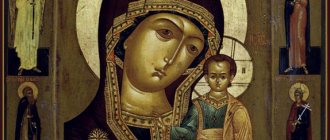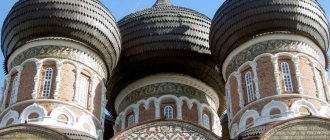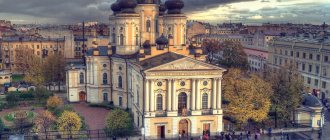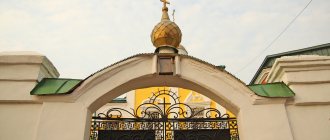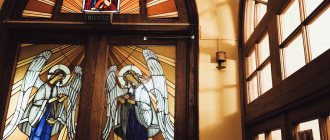Bible cartoons:
"Christmas"
Director Mikhail Aldashin
Russia, 1997
Drawn good world
Bible parables
Year of release: 2009 Genre: Hand-drawn cartoon Duration: 00:25:00 Director: Sergey Antonov
"Stories of the Old Testament". In 9 episodes
Directors: D. Demidov, I. Monaenkova
Russia, 2010
List of episodes
“Stories of the Old Testament” in 35 episodes
Animated New Testament Stories
Nest entertainmont and Rich Animation Studios
"Prince of Egypt"
The Story of Moses
Directors: Brenda Chapman, Steve Hickner, Simon Wells. USA, DreamWorks, 1998
"Annunciation"
About the Feast of the Annunciation
The revived Cathedral of the Kazan Icon of the Mother of God was opened in Kazan
In the capital of Tatarstan today, on the day of the Kazan Icon of the Mother of God, a revived historical cathedral in honor of this shrine, one of the most revered in our country, was solemnly opened. The rite of consecration was performed by Patriarch Kirill. The former stone temple was blown up during Soviet times. A new one was built on the site where the miraculous icon was found literally by the whole world, this was noted by Vladimir Putin, who sent congratulations.
Returning home - this is what they say today about the opening of the recreated cathedral. The icon is finally at the place where it was found, in Kazan.
The ancient icon was found by the girl Matrona. First a chapel was built on this site, then a wooden temple, then a stone one. The last building was erected in 1808; the temple was a place of pilgrimage for believers from all over the country. But in the 30s of the 20th century the cathedral was destroyed.
“Today we are witnesses of how, in a place where no manifestations of religious life were supposed at all, this majestic cathedral was consecrated as a monument to the spirit, courage, strength and faith of our people. And how wonderful it is that representatives of the Islamic clergy are with us today. Today we are together, all of us, as those who maintained solidarity with each other during the difficult years of persecution, and on this solemn day together,” said Patriarch Kirill.
The restoration of the temple was first discussed back in 2004, when a copy of the icon of the Kazan Mother of God from the chambers of the Pope in the Vatican was transferred to Kazan. And so in 2016, a decision was made to restore the temple in its original historical location.
“Exactly five years ago, we, led by His Holiness Patriarch Kirill, laid the first stone in the foundation of the reconstructed temple. And today, in this majestic cathedral, in the presence of the patriarch and distinguished guests, the Divine Liturgy is celebrated again. The capital of Tatarstan and our glorious Fatherland have once again found one of their main spiritual shrines,” said the head of Tatarstan Rustam Minnikhanov.
Five years of construction. Fuzzy old photographs, archival drawings. Archaeologists first worked on the site. Found the foundation.
“Over the years, while Sviyazhsk and Bolgar were being restored, the team was formed, the best forces were brought in,” said Mintimer Shaimiev, chairman of the board of trustees of the Revival Foundation.
Today's event is being handed out as historical. The huge temple was restored by the efforts of believers and business. Vladimir Putin also sent his words of congratulations to Kazan today.
“The Cathedral of the Kazan Icon was built through the efforts of scientists and restorers, museum and library employees, priests, philanthropists, volunteers, literally built by the whole world. I am confident that the cathedral will become one of the spiritual centers of Kazan and will serve the cause of the revival of religious shrines and age-old traditions in the ancient land of Tatarstan,” Igor Komarov, the plenipotentiary representative of the Russian Federation in the Volga Federal District, read out the telegram.
Today at the lighting, many noted that the day of the discovery of the icon of the Kazan Mother of God coincided with one of the main Muslim holidays, Kurban Bayram. This is symbolic of multinational Russia, where different peoples have lived in peace for centuries.
“The most important values are the same for everyone. This is love for one's neighbor, caring for one's family, honest work, and the desire for justice. And I am sure that the consecration of this wonderful cathedral in the very heart of Kazan will be the next step to preserve unity, trust, and mutual understanding between peoples. This is something that our country is rightfully proud of,” said Chairman of the Federation Council Valentina Matvienko.
The temple will open to believers tomorrow. A unique ancient cave temple, which was accidentally discovered during excavations, will also be available for visiting. It is there that the place where the shrine was found is located.
Lives of the Saints:
"Brothers"
About Saints Boris and Gleb
Director: Artem Lukichev. Russia, 2012.
"The Tale of Peter and Fevronia"
About Saints Peter and Fevronia
Directed by Nadezhda Mikhailova. Russia, 2008
"About St. Basil"
Directed by Natalya Berezovaya. Russia, 2008.
"Yegory the Brave"
Directed by Sergei Merinov. Russia, 2009.
"Reverend Seraphim of Sarov"
Directors: Vladislav Ponomarev, Alina Ivakh. Russia, 2008
"Peresvet and Oslyabya"
Director: Stanislav Podivilov. Russia, 2008.
"Andrew the First-Called"
Russia, 2012
"The most ordinary story"
For children about the life of St. Sergius of Radonezh
Russia, 2014
Christian stories and fairy tales:
"Chrismas story"
A film adaptation of the fifth story from “Christmas Tales!” Charles Dickens - A Christmas Carol: A Christmas Ghost Story
https://youtu.be/J4NrSJXSQQ0
Directed by Robert Zemeckis. USA, Walt Disney Pictures, 2009
"Polar Express"
Directed by Robert Zemeckis. USA, Warner Bros., 2004
"Yuletide Stories"
https://youtu.be/gbASP48NPCI
Directed by Irina Kodyukova. Belarus, 1994-2007
"Soldier's Song"
Directed by Elena Chernova. Russia, 2009
"A Tale with an Angel"
https://youtu.be/68CdHd1ptAA
Directors: D. Palagin, A. Kondrashov. Russia, 2004
"The Snow Queen"
Directors: Lev Atamanov and Nikolai Fedorov. USSR, Soyuzmultfilm, 1957
"Ugly duck
Director Vladimir Degtyarev. USSR, Soyuzmultfilm, 1956.
"The Enchanted Boy" (The Adventures of Nils)
Directors: Vladimir Polkovnikov and Alexandra Snezhko-Blotskaya. USSR, Soyuzmultfilm, 1955
"The Tale of Bygone Years." In 24 episodes
Directors: Maria Khovenko, Inga Monaenkova. Russia, 2011
"The Extraordinary Adventures of Seraphim"
https://www.youtube.com/watch?v=tZeg3RPO78Q
Directed by Sergei Antonov. Russia, 2015
Film website
Angel
– based on a story by Hans Christian Andersen
Director - T. Ivanova, 1996
There is the Iberian heart...
Iveron Icon of the Mother of God The Aegean Sea was agitated all day and all the long starless night. The salty water, frozen to the point of bitterness, fell discontentedly onto the land, as if trying to level the shores and, if not break the high sharp rocks, then at least knock them down, and maybe even erase them completely. It seemed that the waves were tired of walking in the confinement of the inland sea, surrounded by bays and rocks that could not be attacked by anyone, they wanted to break free and rush across the rounded earth, sweeping away everything in their path. Arrange another global flood - the last, final one. And a drop wears away a stone, especially a salty drop - the waves knew this well and tirelessly undermined the coastal cliffs, although there were no visible results of their perseverance. But the soft water was in no hurry; it had millennia, and maybe even tens and hundreds of thousands of years at its disposal. And some cataclysm could come to their aid.
Resting after a stormy onslaught, the waves seemed to caress the rocks, stroking their sides, but as soon as the sirocco rose, they, rested, pounced on the cliffs with renewed fury, one after another smashing their elastic, salty breasts into pieces on sharp, unyielding and merciless stones. Sometimes a “white squall” would fly in, and then the spray would change from silvery-greenish to soft white, foamy, and the entire coastline would be outlined by a wide milky border, an uneven ruffled edge. The waves near the strait were especially riotous. There they were simply furious because of the lack of space and beat on the narrowing shores as if they intended to widen the passage to the Sea of Marmara.
***
The whole Empire was also stormed. So church life flowed smoothly until Leo the Isaurian caused trouble in the Christian Empire and the Orthodox Church. For seven centuries, the veneration of icons was not in doubt, because it is natural. For example, I would like to have a portrait of the Emperor or my beloved woman. And the image of Christ the Savior even more so. What is Orthodoxy without icons?! Either the current basileus remembered his Syrian roots, or something else, but suddenly, by imperial decree, as if on command, they began to destroy holy icons and persecute icon worshipers. The imperial edict gave the iconoclasts complete freedom. A lot of blood was shed throughout all regions of the vast Empire, many beautiful icons were mercilessly destroyed, even more frescoes and mosaics were barbarously knocked off the church walls.
A lot of blood was shed, many beautiful icons were mercilessly destroyed, even more frescoes and mosaics were barbarously knocked off the church walls.
At one time, after the reign of the furious iconoclast Constantine Copronymus, it seemed that the fierce iconoclasm had subsided, but a hundred years later power passed to Emperor Theophilus, and the war against the icon, against the church prayer image flared up with increasing force. In the churches that remained untouched, the frescoes were plastered or covered over, the mosaics were torn apart, but the icons found a place and salvation in home chapels. And this could not be tolerated.
By order of the Emperor, special detachments were created that went from house to house and selected icons. Sometimes they were destroyed right on the spot, in front of the admirers, other times they were collected in a heap, chopped into chips with swords and burned in the evenings, rubbing their hands and warming themselves at the fires made of holy images. Well? And the Apostle Peter, on a cold eastern night, stretching out his palms to the fire, denied the Savior three times. But at the first crow of the rooster, he cried bitterly.
The soldiers do not abandon the Savior, they act in the name of Christ. They are simply fighting against the veneration of icons, which is “idolatry,” as the imperial edict says. Besides, they have orders. Therefore, without further ado, they turn the image of the Son of God into scarlet coals, cinders and ashes. The soldiers talk loudly, make blasphemous jokes, laugh, not without vague fear, looking at the fire restless in the wind. And the dark prayer faces, without being distorted, hide in the flames, as if they go into another world, ready to be reborn on a new icon, in order to again absorb the prayers of believers and the requests of faithful hearts. But the Emperor's mercenary warriors do not want to know this. They see good wood that ignites easily and burns so brightly. There are no icons, there are “idols”. Helpless. And unreasonable admirers attribute some kind of power to them. Well, isn't it stupid?! New idolaters - that's who they are! And we know what attitude should be towards idols. And the Holy Scripture says: “You shall not make for yourself an idol” (Ex. 20:4), that is, an idol that you worship.
What can we say about ordinary soldiers, when the Emperors, be it Leo the Isaurian, his son Constantine Copronymus, who convened the iconoclastic council, or the present Theophilus, could not understand that the icon is not an idol, but a prayer image, a church image on which it is invisible , but the prototype is really present with its Divine energy: on the images of the Mother of God - the Mother of God Herself, on the icons of the Savior - the Lord Christ Jesus Himself with His divine-human grace, on the images of saints - they themselves, by the prayerfulness of their souls, pure to the point of transparency before the Eye of God, also by grace their spirit, imbued with holiness from the Holy Spirit.
There was a rumor among icon venerators that one day a flame broke out at such a blasphemous bonfire, like the famous Greek fire, so much so that the faces of the soldiers were burned. Of course, they were only fulfilling their military duty, but still... It was fire, and at the same time light, brighter than the sun, and everyone who had a hand in destroying the icons suddenly went blind. One’s beard and mustache burned to the skin, leaving terrible purple-black ulcers on his face; another’s half of his face was charred. And everyone’s eyebrows and eyelashes were singed. They said after the restoration of icon veneration that those of them who repented before the icons received their sight. Those punished stopped seeing the “white light”, and it is called that because the Sun of Truth - Jesus Christ - is the true Light. They stopped seeing His image. Yes, there were times when icons were discussed not only at Ecumenical Councils, but also around bonfires made from icons, and even in bathhouses, as eyewitnesses testified to those heated debates to the point of hoarseness and clashes to the point of murder.
Nicaea, the site of the meetings of two Ecumenical Councils - the First and Seventh, the first and last, which restored the veneration of icons - did not escape the fate of other cities. Yes, Nikea! There is no other city like it on earth.
The soldiers of the special detachment, like hungry wolves, tirelessly scoured the houses, they were helped by sharp-nosed foxes - informers who sniffed out who had a secret chapel with icon idols in their house, who exchanged the worship of the Lord Jesus Christ Himself for the veneration of His image. It was the turn of one widow. In her prayer room there was an icon of the Mother of God known throughout Nicaea; there was no need for spies here. If the iconoclasts did not spare the image of the Savior on the Brass Gates of Constantinople, then will they spare the icon of His Mother? Knowledgeable people warned the pious widow about the arrival of the imperial detachment. But everything happened so quickly, because from blessed Constantinople to no less blessed Nicaea there are only 750 stadia.
They entered without knocking. However, a knock could be considered a blow with the hilt of a sword on a light door. Anastasia met them at the very door. Crossing her arms over her chest, she, defenseless but full of faith, convinced of the miraculous power of holy images, stood alone against the armed soldiers, waiting for their first word. Her face seemed pale, but not from fear, but from bright spiritual concentration, readiness to suffer even to death. Huge black iconic eyes half-length looked calmly and sternly. They shone with a dark light such a depth, in which the entire centuries-old and long-suffering history of the Greek people, all of Homer, the entire experience of antiquity, all the world's sorrow for a sinful man who does not know what he is doing, seemed to freeze.
“Is it so, madam, that you still keep the famous icon in Nicaea and even invite not only your friends, but also all the residents of the city to venerate it?” The merits of your late husband will not help you now. Besides, they say in the capital that you are spreading rumors about her miraculous powers? We'd like to see the image.
“And test his miraculous abilities,” added a soldier named Barbarian in an obsequious mocking tone. He held a spear in his hands, while the others had gleaming swords, half drawn from their scabbards.
Everyone laughed uncertainly and strainedly.
The widow led the soldiers into the chapel. There were several small icons there, but one that attracted attention was a huge, impressive one. The Mother of God looked at the iconoclasts with human attentiveness, as if looking into their souls.
“It’s her,” one of the soldiers said confidently. – The rest can just be chopped into chips.
The widow stood in front of the dark icon, blocking it with her figure. The majestically raised head with burning eyes came in front of the Holy Face of the Mother of God, and the halo surrounding the head of the Most Holy One involuntarily became the halo of the pious widow. Suddenly it flashed with a blinding light, which painfully, painfully slashed across the eyes of the iconoclasts - and again became a simple colorful golden glow in the image. The soldiers backed away in surprise and, rubbing their eyes, raised their weapons, as if in defense, as if fearing an attack. The widow did not see the light and therefore thought that they took a step back to rush at her and the holy image.
- Wait, wait! I'll pay. As you want. Leave this image with me for just one night. Give me the opportunity to pray before him one last time. And tomorrow morning I will give it to you with my own hands. Just tell me the price.
To confirm her words, she handed the commander of the detachment a handful of coins: a gold solidus and several silver miliaris. Deposit.
The spear slipped, and a wound remained on the cheek of the Ever-Virgin, from which human holy blood flowed
The soldiers conferred in whispers. It was impossible to say that by ruining the widow's house they would have become rich. But setting a price in money, gold, jewelry and receiving them the next morning without hassle seemed tempting. Debt and thirst for profit did not fight for long. Only a soldier with a spear sought, at any cost, right there, on the spot, to destroy the icon, known throughout the Empire. But the passion for profit, as most often happens where there is no faith, won. The dissatisfied Barbarian was the last to leave. In irritation at the failed pogrom in yet another Orthodox chapel, before stepping outside the threshold, he struck his terrible weapon directly at the Holy Face. The icon should have split into pieces, but the spear slipped, and a gouged wound remained on the cheek of the Ever-Virgin, from which human holy blood immediately flowed out. The other soldiers no longer saw this, they left the widow’s house behind them and discussed a simple question: whether they had sold too cheap by asking the widow for the first amount that came to mind. They later said that a soldier with a spear stood on his knees all night a few steps from the widow’s house. He tried diligently to wipe the blood from the tip of the spear, but it came out of the tip again and again.
Early dawn the next morning, in the pale light of the sun that had not yet risen from behind the jagged rocky horizon, Barbarian saw a widow with a large bundle on her back, which a young man, more likely a teenager, helped carry, set off on an unknown journey. They looked back at the city. Now the twelve-meter walls seemed especially high and slender, despite the thickness invisible from below, which during the siege allowed three carts carrying ammunition and weapons to pass each other. True, the thickness of the walls was not visible from below. The fortress with all its thousand-ton weight, walls and numerous towers, and there were about a hundred of them, confidently trampled the soft earth on the lake shore. And the earth did not feel heavy. She obediently carried on her body many such stone fortresses that seemed impregnable.
A citadel, a fortress, this is what the faith of the icon-worshippers could be compared with, the thought flashed through the widow’s mind.
They walked all night along the southern shore of the lake to reach the bay, and the spearman, stealthily, now through the sand, now through the dewy grass, now over sharp stones, silently followed them. Several times they made short stops to rest, and the widow recited prayers, individual words of which were heard by the soldier, who did not let go of his weapon with dried blood on the tip. In the morning they reached a rocky shore. The morning waves seemed not to welcome people. They ran onto a narrow strip of sand between the rocks, grumbling displeasedly but restrainedly about something, almost without disturbing the early, fresh silence that seemed to spread throughout the whole world.
The barbarian thought. There was no way a teenager could be a brother. This means that this is the son whom she probably hid with neighbors or relatives the day before. In the half-light of the morning, against the pale background of the sky, the soldier saw the mother and the teenager in profile. They were strikingly similar to each other. It seemed that if they were placed on top of each other, like coins, the outlines of the faces would coincide down to the smallest detail. Of course, the teenager will become a man, his face will acquire more severe features, and the similarity will decrease, but for now...
The widow unwrapped a large package, which contained that same icon. However, Varvara guessed this long ago. The icon stood on the wet sand, supported on one side by the widow and on the other by her son. The woman knelt down and pressed her lips and forehead to the image for a long time, gently and respectfully stroking the Holy One’s robes with her fingertips, as if collecting, absorbing grace and asking for forgiveness. After her, her young son did the same. The barbarian continued to watch, fearing to frighten off the admirers of the wonderful image.
At sunrise, when the first ray slid upward into the heavens, and from there descended to the icon of the Mother of God, the Barbarian once again saw the bloody stain on the cheek of the Mother of God - and for the first time in his life he cried, burying his forehead, eyelids and nose in the wet sand. The salty tears were instantly absorbed into the salty sea sand. When he raised his head, he saw the widow and her son entering the water. The waves are already hitting them at the waist. Stormy, they make their underwater gait unsteady, mother and son sway from side to side, stumbling, as if afraid to drop the image into the water. Maybe their feet are being cut by sharp stones. But then why did they enter the salty greenish water hills, which, one after another, run into two fragile figures, elastically push them in the stomach, trying to force them to take a step back. Sometimes this is successful, but after that people again slowly move a few cautious steps forward.
– If we leave it here, the waves may carry the icon to the shore and break it against the rocks.
The woman crossed herself and in a quiet, confident voice, looking straight into the eyes of the Mother of God, said:
- Most Holy Mother of the Virgin, deliver Your holy image from drowning by water!
A light gust of wind brought these words to Varvar, and he involuntarily crossed himself after the woman. Mother and son, so alone against the backdrop of the vast sea and the vast sky, once again placed the sign of the cross on themselves, laid the icon flat on the next wave, slightly pushed the board towards the open sea and lowered their powerless thin hands - female and youthful. And then not only the Barbarian, but also the widow and her son backed away. The icon suddenly stood up to its full height, and the sea calmed down. They had never seen such a surface of water in their lives. The peace and silence of the seventh day descended from above, when the Lord, having created the Universe and man, rested from his labors. The bay turned into a huge living oval mirror, into which only the cloudless sky and the wonderful Face of the Mother of God looked. The icon, like the sail of an invisible submarine, quickly rushed into the Sea of Marmara. The rebellious Aegean Sea also humbled itself, the “white squall” subsided, dissolved in the water and air, and someone invisible supported the sliding into a future unknown to us, but open to the holy miraculous image.
The widow blessed her son to go to Mount Athos and take monastic vows. Anastasia herself returned to her native Nicaea and suffered martyrdom for hiding the miraculous icon.
The icon suddenly stood up to its full height, and the sea calmed down. They had never seen such a surface of water in their lives.
And the Barbarian? He followed the widow's son and became, as it were, his sworn brother. And the self-proclaimed son of Anastasia. He threw a spear with a speck of blood into the waves. The barbarian looked for a long time at the place where the familiar weapon fell, as if he hoped that it would not drown, but would float to unknown lands after the icon that it had wounded. But the heavy spear sank to the bottom almost without splashing, and the salt water dissolved the holy blood on its tip.
Is it necessary to clarify that this was the famous miraculous Iveron Icon of the Mother of God, which later sailed to Athos with a wound on her cheek and remained there, receiving the name Portaitissa, the Goalkeeper of the famous monastery?..
***
The widow's son went to Thessaloniki, from there he moved to the Holy Mountain, took monastic vows there and spent many years ascetic in those places where the Georgians later founded the Iveron Monastery at the expense of the royal Bagration dynasty. The widow's son's companions and companions more than once listened with bated breath to his story about how the icon rose above the surface of the sea and flew into the distant distance, towards the sunset.
Many mysterious events are associated with miraculous icons. So the history of the Iveron image of the Virgin Mary is shrouded in mystery. The holy icon flew away and disappeared. For two centuries the Orthodox people heard nothing about her. Where was she hiding? Who? Why? But then one day the inhabitants of the Iveron monastery on Athos saw in the sea opposite the monastery a pillar of fire that reached the sky. Such a pillar was probably seen by the chosen people in their wanderings in the desert. The miraculous phenomenon was repeated for several days and nights. And they were afraid to approach the amazing pillar. Monks from neighboring monasteries and kalivs came to that place, stood on the shore, amazed by the miracle, crossed themselves with reverence, not daring to get into the boat and approach the fiery miracle. One day the light emanating from the pillar weakened, and everyone saw that the pillar of fire was going into the sky from the icon of the Mother of God. Then they decided to take the boat. However, the closer they swam to the shining image, the further into the sea the icon and the pillar above it moved. The monks returned to the monastery, entered the temple and, together with the abbot, began to pray to God and the Mother of God with tears, so that they would be worthy to receive the amazing shrine in their hands in order to place it in the monastery for veneration and prayer.
Once the inhabitants of the Iveron monastery on Athos saw a pillar of fire in the sea that reached the sky
In the dead of night, the Most Holy Theotokos appeared in a dream to the Georgian elder Gabriel, illuminated by heavenly light, and said: “Tell the abbot and the brethren that I want to give them My icon, My protection and help; then enter the sea, walk with faith on the waves, and then everyone will know My love and favor towards your abode.”
Elder Gabriel was a true monk: a strict life and at the same time a childish, meek, simple disposition. The tops of inaccessible rocks were his refuge in the summer, and in the winter he went to the monastery. The only clothing left on him was a hair shirt; he ate only vegetables and water. In accordance with church hymns, the brethren called him an earthly angel and a heavenly man.
The elder told the abbot about his dream. And so in the morning the monks with censers and candles went ashore and performed a prayer service. Gabriel walked on the water with prayer, “as if on dry land.” We all remember how the Apostle Peter doubted and began to drown. The price of doubt is terrible. Elder Gabriel called on God and the Mother of God for help, and with faith that moves mountains, he went to the holy icon and took it in his hands. A friendly and joyful sigh of relief was heard on the shore: the Lady deigned to visit the monastery. In the same way, walking on the water, Gabriel returned to the shore.
A collective sigh of relief was heard on the shore: the Lady deigned to visit the monastery
A chapel was erected right there on that spot and thanksgiving prayers were served for three days and three nights. Where should such a shrine be kept? Of course, in the altar, in the holy of holies of the cathedral church. And so they did.
Early in the morning before Matins, one of the monks, out of obedience, began to light the lamps in the altar and discovered that the icon had disappeared. Soon she was found above the gates of the monastery. The monks did not come to their senses and again brought the icon into the altar. However, the unauthorized and miraculous transfer of the image of the Mother of God from the temple to the monastery gates was repeated twice more. And again, thanks to Elder Gabriel, the confusion was resolved. The Mother of God appeared to him in a bright radiance and commanded: “Announce to the brethren: I do not want to be protected by you, but I wish to become your Guardian. As long as you see My icon on the gate, until then the grace of My Son to you will not fail.”
In gratitude, the inhabitants of the Georgian monastery erected a gate temple and placed an icon in it. As you know, she remains there to this day. That's why the Greeks call her Portaitissa, and the Russians call her Goalkeeper. For She herself was pleased to choose the place of Her stay - at the gates.
This naming of the miraculous icon is deeply symbolic. The Mother of God guards the gates of the monastery from enemies who have attacked the monastery more than once. One day, the Persians, led by the governor Amira, sailed to Mount Athos on 15 ships. Having gone ashore, they surrounded the monastery. The monks, taking precious sacred vessels and the miraculous Iveron icon from the temple, hid in one of the towers. The Persians entangled the pillars of the cathedral temple with ropes and tried to bring it down. The inhabitants cried out with tears to the Mother of God for salvation. And suddenly a strong storm arose at sea, and the ships with the soldiers remaining on them sank. The leader of Amir survived. He not only repented of what he had done, but also donated a lot of gold and silver to restore the monastery walls, which were then strengthened and made higher than before.
But we are not only talking about such real protection and patronage. Our Lady of the Goalkeeper also closes the gates to the “spirits of evil in high places.” And at the same time she opens the gates! Which? Let’s take the akathist in our hands and find the answer: “Rejoice, good Goalkeeper, who opens the doors of heaven to the faithful!”
And yet, more often the holy image is called not Portaitissa, but after the place of its appearance on Athos - Iveron, because Iveria is the ancient name of Georgia.
On the reverse side of the frame of the Iveron Icon there is an inscription in Georgian. Here is its translation:
“O Lady, Mother of the philanthropic God, all-immaculate Bride Mary! Save the soul of my lord Quarquhar, son of Kai Khozroy. I, Your servant, thank You that You have deigned me, unworthy, to gild and decorate the holy icon of Your Goalkeeper. Behold, I bring You a small gift; accept it from me, a sinner, and keep me blameless in life, and on the day of the departure of my soul, intercede and make a handwriting of my sins invisible, placing me, a sinner, at the right hand of Your Son and God, as all glory is due to Him, with His beginningless Father and the All-Holy and Good and By the life-giving Spirit, now and ever and unto ages of ages. Amen".
The famous traveler to holy places V.G. Barsky (1723–1747) describes the icon as follows:
“In this beautiful church, at the inner gates of the monastery, in the iconostasis, instead of the regular icon of the Mother of God, there stands a certain holy and miraculous icon, named from the ancient monks the Goalkeeper, with great feathers, holding Christ the Savior in her left hand, blackened by many years, everything, except the face, is covered with silver-gilded clothing and, in addition, studded with valuable stones and gold coins from various Tsars, princes and noble boyars, given for Her many miracles; where the Russian Tsars and Queens, Emperors and Empresses, princes and princesses, gold coins and other gifts were hung in the sight of my hair. This holy icon also has a sign, or a scar of an ulcer, on the cheek, which was received in ancient times from one who was previously unfaithful and was called a Barbarian and struck with a knife out of malice and hatred; follow, when you saw that Abi had bled a lot of blood, even to this day, he repented and believed, and the monk became a hermit, and was saved, and now he is called Saint Barbarian, and there is depicted there in the threshold of the black, like Moses Murin, but the youngest, and with their former weapons, with a knife, arrows and a bow.”
***
In the Iveron Chapel When and under what circumstances did the Iveron Icon end up in Rus'? Indeed, thanks to the Iveron Chapel at the entrance to Red Square, it became one of the most revered icons not only in Moscow, but throughout Rus'. And it must be said that Muscovites saw the miraculous Athos icon quite late - in the middle of the 17th century. In those days, Orthodox clergy from Greece often came to Rus' to collect donations. And so Archimandrite Pachomius arrived in Moscow to collect offerings for the Athos monasteries. The future Patriarch Nikon, who was then the rector of the Novo-Spassky Monastery, on the advice of Tsar Alexei Mikhailovich, ordered from him an accurate copy of the miraculous Iveron Icon. The icon arrived in Moscow in 1648 with three monks of the Iveron Monastery. They also delivered a letter describing in detail the work of the Athonite icon painter.
Here is an excerpt from the letter:
“When I arrived (Archimandrite Pachomius) to our monastery, having gathered all my brethren, 365 brothers, I created a great prayer service from evening until daylight and blessed the water with holy relics; they poured holy water over the miraculous icon of the Most Holy Theotokos, the old Portaitskaya (that is, the Athonite Iveron Goalkeeper), and collected that holy water into a great basin, having collected it, they again poured it on a new board, which they made all from cypress wood, and again collected that holy water into the basin; and then they served the Divine and Holy Liturgy with great boldness and faith, and after the Holy Liturgy they gave that holy water and holy relics to the icon painter, priest and spiritual father, Mr. Iamblichus Romanov, so that he could paint an icon. And that icon (the new copy of the Iveron Portaitissa) does not differ in any way from the first icon, neither in length, nor width, nor face - only word for word it is new, just like old.”
The Iveron Icon was met at the Resurrection Gate of China Town: the Royal Family, the Patriarch and many people were present. The Iveron Chapel was built on that spot. In the same year, 1654, the icon was sent to the Russian troops who were on a campaign against the Poles. The surviving documents say that “The Sovereign Tsar and Grand Duke Alexei Mikhailovich of All Rus' released the miraculous icon of the Most Pure Mother of God of Iveron from Moscow to Vyazma.” It is also specified that it was brought from Constantinople under the then Patriarch of Constantinople Parthenia. To accompany the icon, the Emperor sent Metropolitan Korniliy of Kazan and Sviyazhsk to Vyazma, and with him three archimandrites and three abbots. This detail is worth paying attention to: in the very first year of its arrival in Moscow, the icon began to enjoy such veneration that a metropolitan, three archimandrites and abbots were sent to accompany it to the troops. In addition, the image was escorted from the Assumption Cathedral of the Kremlin to the Donskoy Monastery by Tsar Alexei Mikhailovich himself and Patriarch Nikon.
The icon began to enjoy such veneration that a metropolitan was sent to accompany it to the troops.
Iveron icons in Rus' are strongly associated with the name of Patriarch Nikon. When the future Patriarch was Metropolitan of Novgorod, he chose a beautiful place in Valdai in the Novgorod diocese. Erected to the Patriarchal throne, Nikon erected a monastery there on the model of Iveron. To do this, on the advice of the Tsar, he sent experienced icon painters to Athos. They not only drew up an accurate plan of the monastery, but also made a list of the original Iveron icon. In 1656, it was moved from Athos to the Valdai Monastery.
In the book “Mental Paradise,” Patriarch Nikon spoke about one event related to the transfer of the icon. The icon painters, monks Cornelius and Nicephorus, did not have the money to pay for the crossing of the Danube. But the boatmen were Muslims, and it was impossible to come to an agreement with them. The monks had already decided to return to Athos, but the Mother of God appeared to them in a dream and strengthened their spirit. That same night, the Mother of God appeared to the rich Greek Manuel Konstantiev and ordered him to help the monks. The Greek paid a fee for them and even refused the gift that Nikon subsequently sent him.
Patriarch Nikon richly decorated the new image, covering it with a frame of pure chased gold with diamonds and sapphires. The cost of the robe, according to the Patriarch himself, was about 44 thousand in the money of that time. With this money it would be possible to build another small monastery. Such was the Patriarch’s love for the miraculous image.
The Iveron icon is extremely popular in Georgia. And this is natural. The Iveron Mozdok Icon of the Mother of God is widely known in the Caucasus. At the beginning of the 13th century, Holy Queen Tamara (and her husband was the youngest son of the Holy Blessed Prince Andrei Bogolyubsky, Yuri) sent a copy of the Iveron Icon to the church of the Ossetian village of Maryam-Kay as a gift to newly enlightened Christians. Three times the icon miraculously emerged unharmed from the fires. In the middle of the 18th century, by order of Catherine II, the Ossetians of the village had to move. Of course, they took the miraculous icon with them. The travelers stopped for the night on the banks of the Terek, near the city of Mozdok. All night the holy icon shed bright light on the surrounding area, but in the morning the oxen harnessed to the cart on which the revered icon stood did not want to move. One Ossetian had a vision: the Mother of God ordered to leave the icon in that place. The Mozdok bishop performed a solemn prayer service and was about to transfer the icon to the city cathedral, but it was also revealed to him that the icon should remain on the shore. A chapel was built on that site, and later the Assumption Church was erected, at which a women’s monastery was founded. How can one not recall here the Vladimir Icon of the Mother of God, which chose its place of residence in the same way.
According to legend, the Iverskaya Goalkeeper defended Mozdok from the attack of the highlanders led by Shamil. Not only the Orthodox of the Caucasus, but also residents of the Don region and Voronezh borders consider the icon their patroness. After the Bolshevik revolution, the icon disappeared, and a copy of it is venerated in the Mozdok Church.
Not only the Orthodox of the Caucasus, but also the residents of the Don region consider the icon their patroness.
There are numerous lists of the miraculous icon. Evgeny Poselyanin describes the amazing, special love for the icon in Moscow, its veneration, begun by Patriarch Nikon:
“...There is no other shrine that would so naturally come into use in Moscow, that would so merge with the life of its inhabitants. From early morning until late evening, you will see the Moscow people of all strata ascending the cast-iron slabs into the interior of the reserved chapel. Many representatives of large Moscow firms will not start a trading day without visiting Iverskaya. It’s rare that a student won’t visit her before exams; and not long before, a young man in a gymnasium or student uniform, who had boasted of his unbelief, with trepidation and hope stares his pleading eyes into the darkened face...
But with such a rush of Muscovites to this chapel, only a very small part of the pilgrims see the original icon, since it is carried almost around the clock to the homes of people who want to receive it. At any hour you can meet a heavy, huge carriage, drawn by six horses, in which on the front side there is a huge icon with a large lantern lit in front of it, fixed in the floor. Something gratifying and happy blows over you at every such meeting. And when the icon is brought into the houses, passing people hastily run up to it and kiss it.
Then, late at night, after midnight, the icon returns again to the chapel, where it is brought for a longer time, but even here it is not left alone. There is a custom in Moscow that people seeking the special intercession of the Mother of God make a vow to go on pilgrimage to Iverskaya a certain number of times at night. After spending some half an hour in the chapel, the icon is taken away again. The desire to receive her is so great among Muscovites that they do not stop at night... And so, day after day, the face of the Mother of God travels around the city of the Mother of God...”
Marina Tsvetaeva revered the Iveron image and dedicated several inspired poetic lines to it:
And behind that door, where the people are flocking, there the Iberian heart, Red, burns.
And “Hallelujah” pours onto the dark fields. I kiss your chest, Moscow land.
The Iverskaya Chapel was demolished in the late 1920s and restored and consecrated in 1995. Now its doors are open, and a new list, delivered from Athos, again accepts the prayers of the faithful.
In conclusion, let's say a few words about the famous Georgian saint - Reverend Confessor Gabriel (Urgebadze; †1995), canonized in 2012. All his life the elder revered the Iveron Icon of the Mother of God (now kept in the Samtavro Monastery, in which the saint died), and when the time came for tonsure, he asked to be named Gabriel in honor of Gabriel of Athos, the same one who walked on water without wetting his feet, and brought to the shore of a miraculous shrine.
